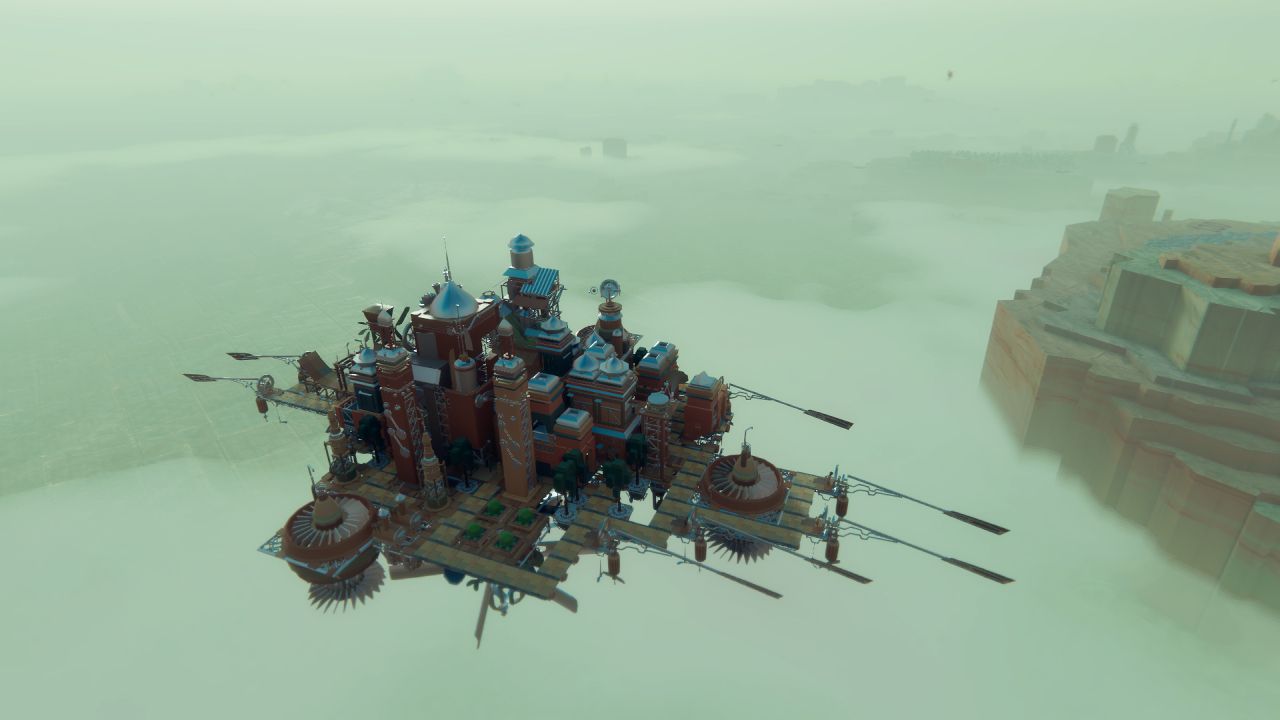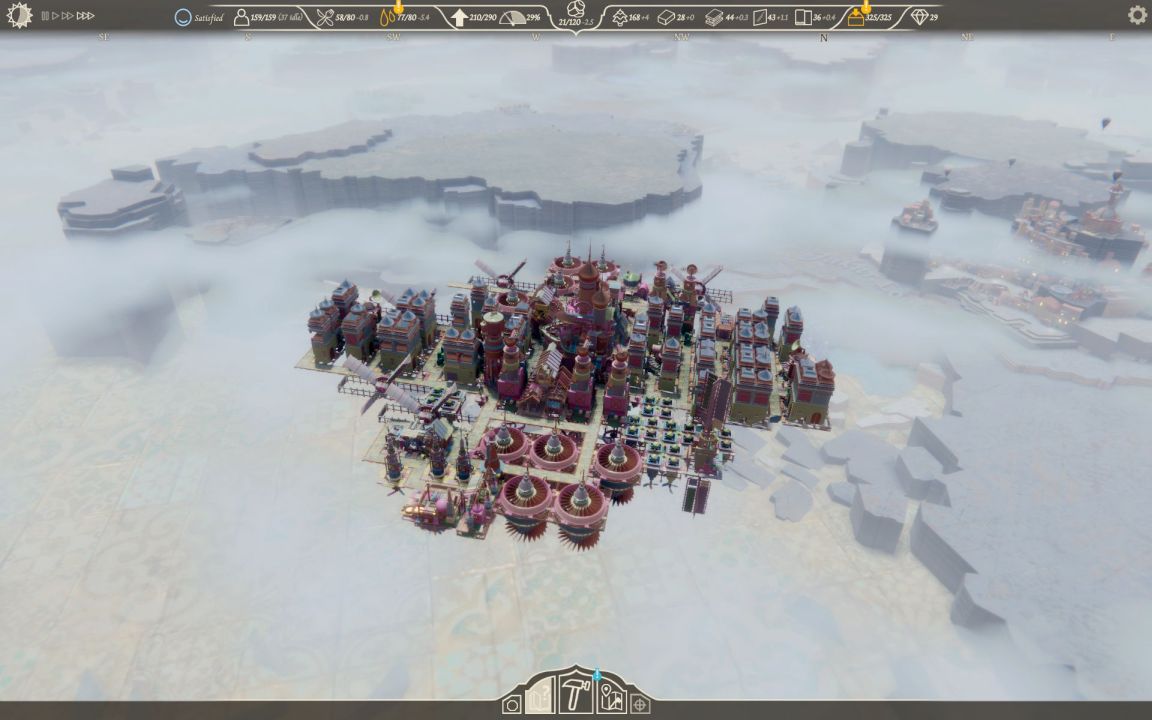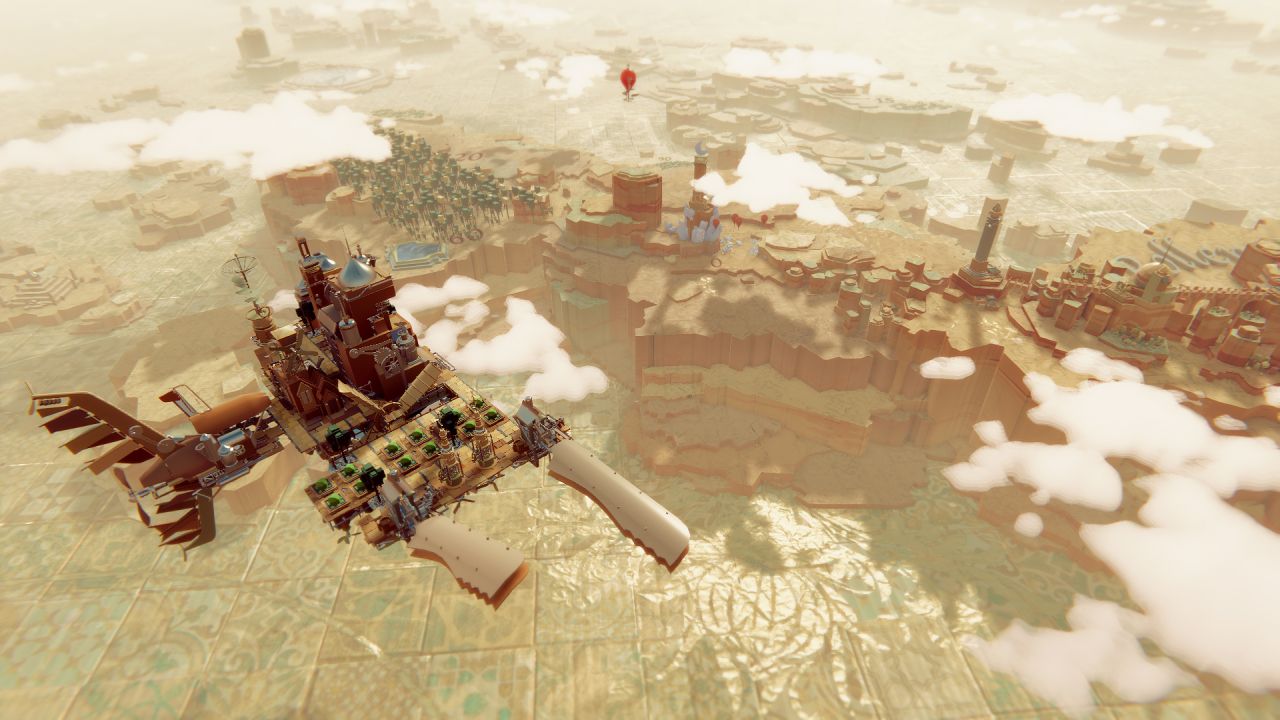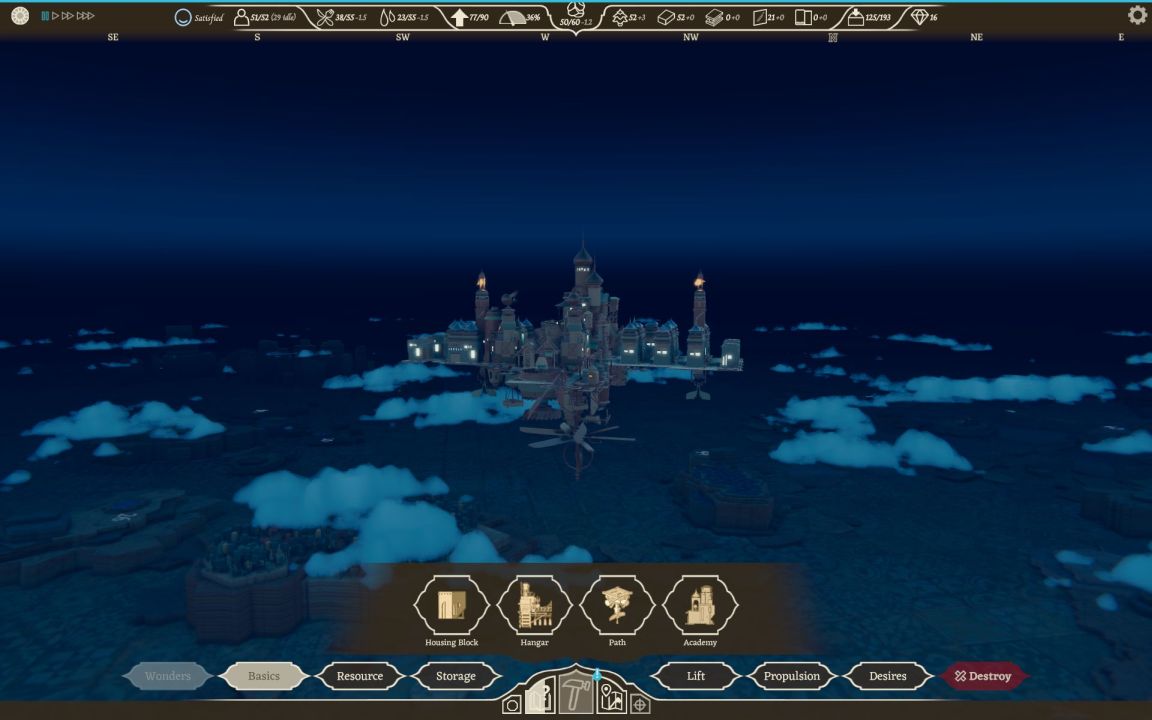Airborne Kingdom Review
At the mercy of the wind
Although it's been a few years since we saw the last SimCity game, the city management genre has been chugging along with a steady stream of quality releases. From the more traditional entries like Tropico and Cities Skylines, to the more unique and outlandish such as Frostpunk and Surviving Mars. The newest entry in this genre is Airborne Kingdom, and it falls into the latter category. This title lets players assume the role of a small floating town center and build up around it, while also travelling across a few different locations in order to re-unite various cities. Including light adventure game elements on top of the floating city-building is interesting, but the game never really takes those unique ideas beyond their most basic iterations. It's a decent game to pass a few relaxing hours floating around, but it eventually grows dull and offers no replay value.

Players are introduced to the world called The Barrens, which consists of three regions and 12 different kingdoms – in reality though, they are just abstract cities that dot the landscape. We learn that long ago, the land was united and the 13th Airborne Kingdom allowed all to live in harmony and prosper. However, that kingdom disappeared, and soon the culture and connection between the remaining land kingdoms was lost. You are put in charge of a newly built floating town center, which hovers high above the land in the clouds, and set out to rebuild the Airborne Kingdom and re-unite the lands. To do so, you will have to visit each city and help them, as well as reach a certain population in your own Kingdom.
The narrative elements are rather slim and unconvincing. As you visit each of the twelve cities, you will read one or two brief text boxes about the local people and their problem. You will then set out to fix this problem, and then build a skyport, which is all that it takes to have the city re-join the domain. The game offers no real details about why these cities lost their connections without you – the terrain looks entirely flat and passable, and the cities are often within visible distance of each other, offering no valid reason for the requirement of air travel. And we don't even learn what happened to the previous skyports.
As mentioned, you are put in charge of a floating town center, a basic starting point not unlike other games in the city building genre. You don't control any people directly, but rather you can place structures on a flat plane and they will get built. Of course, the key difference is that you're floating high in the air, but this ends up being largely a non-factor. You place paths which are required and act as your foundation, and then buildings are placed on the sides of the paths. Homes are important, but you will also need an academy for research, storage warehouses for raw materials, processing buildings that turn raw materials into usable ones, and so on. Space is at a bit of a premium when you're floating in the sky, so a few of the upgrades allow you to stack structures on top of existing ones – such as homes and storage warehouses – so you don't have to keep building outwards.
While the resource management and processing, as well as population happiness, are all pretty standard mechanics, the unique aspect is the fact that you're floating around. To that end, you have an uplift stat, which will limit how much you can build. In order to increase uplift, you'll have to construct items such as large fans and other contraptions. It's a very forgettable mechanic; a basic construction gating stat that is easily boosted. You can unlock a few different uplift mechanisms, but one of the very first ones you get may cost a lot, but it generates a ton of uplift, so you just build a few of those over the course of the game. You also need to be moving, and for that you need speed. Propulsion items can be constructed, such as various sails and wheels, that give you increased movement velocity, so you're not floating for hours just to get somewhere.

The academy is a key building to consider. This is your research center that lets you unlock new buildings, and improve the efficiency of existing structures. The more academies you have, the faster new perks are unlocked. Having three or even four academies (due to their relatively low construction cost) makes you speed through the short research tree, improving the efficiency of everything – from your propulsion and uplift structures to your resource processing, reducing how much food and water the people consume, and so on. The rapid research feels satisfying, but it will likely leave you without much worthwhile items to research towards the end of the game, as you've already got everything you wanted.
Another floating-related mechanic is tilt. Depending on how you build paths and place buildings, your city may begin to tilt in any of the four directions, which reduces happiness and makes it dangerous. But again, it's quite easy to be symmetrical with your structure placements, and not really have to worry about tilt. Coal is the material that acts as fuel for your uplift contraptions, but except for one area of the map, it's not something you have to worry about running out of.
On the subject of materials, there are just a few that you'll be able to collect by sending workers in airplanes to the ground below. Coal is needed to power your uplift, but it's collected and used raw so it has no delay in becoming useful. To construct buildings, you'll also need wood, which is also used raw. Other materials need processing, so you'll need to construct a single building for each. Clay is used to make adobe, iron is produced from ore, glass from quartz, and canvas from special outcrops. And so you construct buildings such as glass smelters to process the raw materials into their usable forms. It's a straightforward one-step process, and is representative of the experience of Airborne Kingdom as a whole.
Besides needing raw materials for construction, you'll also need supplies for your citizens – namely food and water. These again can simply be collected from the ground below, or later on in the game you can unlock farms and water collectors that allow you to become a bit more self-sufficient. Other than food and water, your citizens eventually will want 60%+ of paths to be lit with lamps (an odd metric, though perhaps understandable so nobody goes tumbling off the edge at night). They will also have Desires - medical care (you just need to construct a few clinics), faith and comfort (you will need to place buildings that produce this within a certain radius of homes). Some of your material and uplift buildings generate a noise, so you'll want to build those away from the housing block.
The happiness mechanic is pretty finicky but it's easy enough to keep everyone satisfied (if not at maximum jubilant level). Running out of supplies, not having enough homes, or not having enough happiness buildings will decrease satisfaction levels, and this may cause citizens to leave – though they simply return when you get the happiness levels back up. The happiness level is needed to keep growing your city – you'll come across tiny villages that dot the landscape, and there up to three new people can be invited to join your city. The three only join if your citizens are at least neutral – satisfied – or jubilant, respectively. Growing your population is needed to reach a certain level for the end of the story, as well as provide you more workers for the various buildings. It's rarely a problem – you'll often have 10+ people simply idling and not working anywhere.

From a gameplay perspective, the fact that you're floating allows the title to become a light exploration/ adventure game of sorts as well. As touched on earlier, your goal will be to visit a number of different locations and talk with people in all corners of the world. Your kingdom floats around on a flat plane, though you can use the camera to look in any direction and go above/below it. Floating close to a resource, city, or a village lets you interact with it; the human settlements produce a quick text box window with interaction options, if there are any. Resources are collected if you select them and send workers there, who fly down and gather. The interactive elements of the ground below get highlighted when you put the mouse over them, which can be sometimes difficult to see because there are often clouds in the way – which disperse when you hover the cursor over them, with a strange effect that can be distracting. At times, it can almost feel like you're pixel-hunting in an adventure game as you scan the nearby horizon for available resources to be gathered. Resources do eventually grow back, but you're rarely going to be returning or taking the same flight path.
This unique setup, while not mechanically complex, does allow you to tap into the addicting resource management cycle with a twist. Watching the resource numbers at the top of the screen to ensure your people have food and water, all while hunting for the raw materials you need, can be engrossing. The game world consists of three areas, with some barren wastelands in-between. Two of these areas warn players that they lack an essential resource – food, water, and coal – so you should have either lots of provisions or have the buildings that generate it.
However, much like the rest of the game, these ideas are executed at their most basic. Difficulty is really nonexistent in Airborne Kingdom – there are no difficulty levels to choose from, and we've already touched on how the uplift, coal, and tilt mechanics are easily mitigated. Managing the resources is easy – even in areas where they are in very short supply, you can simply trade using other raw materials with the cities to get what you need. Re-arranging paths and structures can be entirely free, thanks to a quick research at the academy. There's no depth to the worker management or production buildings – you can't tweak anything, like their efficiency or shut them down. By late game, you will have already built everything you need and you are even dumping resources to make space for those you need; you likely have already researched all you want, and now are just clicking on random things in the tech tree. Unless you take it upon yourself to have an extremely happy population in a perfectly aesthetically pleasing floating city that uses every type of propulsion and uplift structure, the game never challenges you to think, plan ahead, or overcome adversity, and by the final third of the game there's nothing left to do but float around and do the extremely simple quests to finish up the campaign.

The adventure side of things is even more shallow and dull. In order to unite the kingdom, you have to help each of the twelve cities with their problem. But in gameplay terms, this boils down to almost exactly the same thing each time. You float over, read a brief piece of dialog, and then you're asked to help construct/repair something, which just means giving the city some materials and a workers, and sit around waiting for the construction to finish. The second type of help a city may need is having you go somewhere else to click on something, read a bit of dialogue, and come back. Then, you build a sky port, and you're done; rinse and repeat with each city. These "quests", if you can even call them that, are dreadfully dull and offer no gameplay value. The only positive here is that the game world isn't very big, so you're not floating for all that long before getting to your next city or destination.
Other than fulfilling their request, you can also trade raw materials with cities – they conveniently have everything available at various values, even in those regions where resources are apparently scarce. They are also the only means to acquire new building blueprints, which unlocks them for research and construction. Only a few of these blueprints are really needed – as mentioned, unless for some reason you want every type of propulsion, there's no point to unlock and research them all. To buy the few blueprints you do want or need, relics are used as currency. Relics are found in crypts that dot the landscape just like raw materials, and you simply send one worker to collect them. So again, not much complexity here, other than perhaps a push for players to explore the terrain. Another reason to explore is to find special pools which unlock visual customization colors for your buildings. You can also find one of three different unique structures which unlock the ability to construct Wonders in the city.
You'll mostly be clicking around to point your floating fortress to its next destination, and the controls are simple enough. Despite being free-form, the camera can be a little unwieldy, but never too annoying. Zooming in and locking-on to our city works well, and placing buildings is easy. The UI is quite basic and could use a little more flair and polish, though it's functional. The draw distance is kind of poor, but is helped along by the atmospheric fog that can roll in, and the day/night cycle. Players can fast-forward time to make the travel and material processing go faster, and that's pretty much needed to make the game enjoyable. The world below has a unique look, though not an overly detailed one – sort of like the style used in the Game of Thrones TV show intro. In a management game such as this music is important, and Airborne Kingdom delivers a good but small selection of tracks that fit the somewhat Middle Eastern vibe of the game, and manage to both be enjoyable and blend away into the background.
Airborne Kingdom has a solid foundation – despite being stuck in the clouds. All the basics are here – resource gathering and management, keeping your population happy, constructing buildings and dealing with the unique aspects of uplift and propulsion. But that's just it – these are basics. The game's most unique elements feel like barebones implementations of interesting ideas, and while some fans may appreciate a few relaxing hours of floating above a mostly desolate world, the game just lacks the edge to keep you invested. Whatever resource management challenges and unique mechanics kept you engaged in the opening hours becomes all but a distant memory by the final dull cutscene that takes less than 6 hours to reach. With no replay value, Airborne Kingdom is a pie in the sky, a promise of something greater that never manages to materialize.
 Comments
Comments












